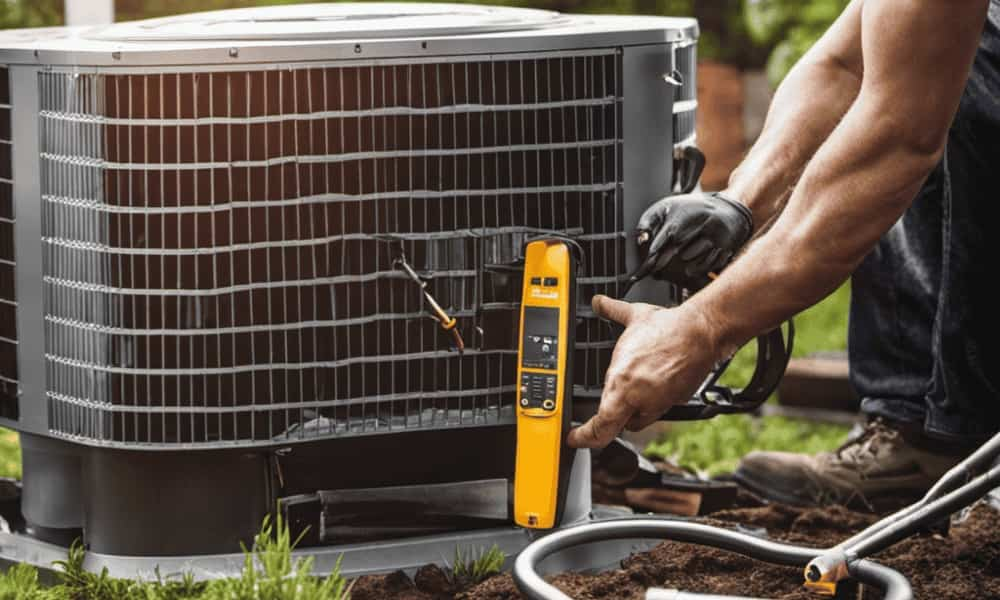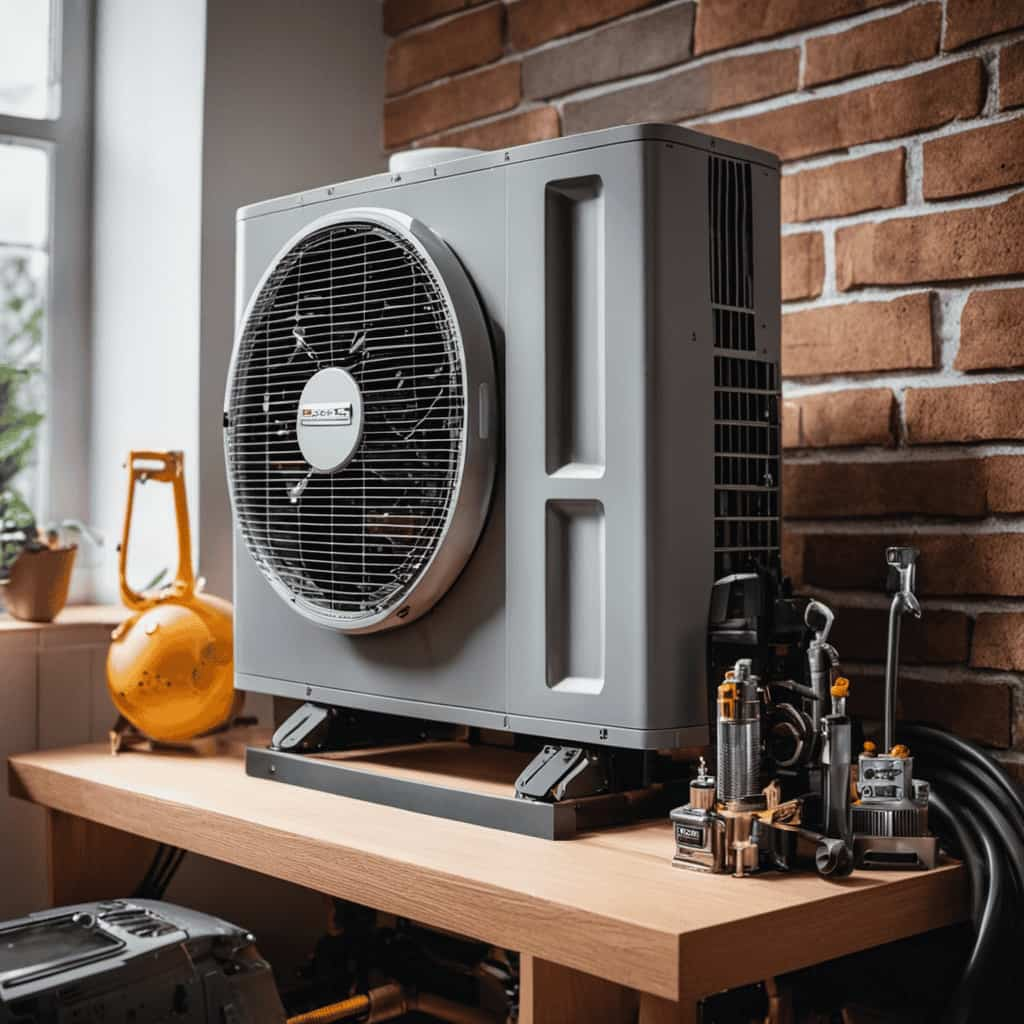Welcome to our guide on optimizing green buildings with heat pump technology. We are here to illustrate the amazing advantages of this energy-efficient solution and assist you in understanding the various types of heat pumps that are currently available.
Our aim is to serve you, the audience, by providing best practices for integrating heat pump technology into your green building design.
Join us as we explore successful case studies and empower you to make sustainable choices for a greener future.
Key Takeaways
- Heat pumps transfer heat from one place to another using a small amount of electricity.
- Heat pumps can effectively heat and cool buildings, reducing energy consumption and greenhouse gas emissions.
- Heat pump technology utilizes renewable energy sources such as air, water, and ground, contributing to environmental sustainability.
- Proper placement, sizing, and control systems are essential for optimizing the performance and energy savings of heat pump technology in green buildings.
The Basics of Heat Pump Technology in Green Buildings
In this section, we’ll explore the fundamentals of heat pump technology in green buildings.

Heat pump technology applications have seen significant advancements in recent years, making them an essential tool for optimizing energy efficiency in sustainable buildings.
Heat pumps work by transferring heat from one place to another, using a small amount of electricity to move heat from a lower temperature area to a higher temperature area. This technology allows us to effectively heat and cool buildings while reducing energy consumption and greenhouse gas emissions.
With advancements in heat pump technology, we can now achieve even greater energy savings and improve indoor air quality in green buildings.
Key Benefits of Heat Pump Technology for Energy Efficiency
We can reap several key benefits from heat pump technology to enhance energy efficiency in green buildings.

One of the most significant advantages is energy savings. Heat pump systems are highly efficient and can provide heating and cooling at a fraction of the energy consumed by traditional HVAC systems. This leads to reduced energy consumption and lower utility bills.
Additionally, heat pumps contribute to environmental sustainability. By utilizing renewable energy sources such as air, water, and ground, heat pumps significantly reduce greenhouse gas emissions compared to conventional heating and cooling methods. This helps to mitigate climate change and promote a healthier environment.
Understanding the Different Types of Heat Pumps for Green Buildings
To fully optimize green buildings, it’s important to understand the different types of heat pumps available and how they can contribute to energy efficiency and sustainability. Here are some key types of heat pumps to consider for your green building:
-
Air source heat pumps: These extract heat from the air and use it to heat or cool the building.

-
Ground source heat pumps: These use the stable temperature of the ground to heat or cool the building.
-
Water source heat pumps: These extract heat from a water source, such as a lake or river, to heat or cool the building.
-
Hybrid heat pumps: These combine multiple heat sources, such as air and ground, for increased efficiency.
-
Geothermal heat pumps: These utilize the constant temperature of the earth for heating and cooling.

Understanding these different types of heat pumps is crucial for effective heat pump installation and maintenance in green buildings. By choosing the right type for your specific needs, you can maximize energy efficiency and minimize environmental impact.
Best Practices for Integrating Heat Pump Technology in Green Building Design
By carefully considering the placement and sizing of heat pumps, as well as incorporating efficient control systems, we can effectively integrate heat pump technology into green building designs. When it comes to heat pump installation considerations, there are a few key factors to keep in mind. First, the location of the heat pump should be chosen strategically to optimize its performance and minimize energy loss. It should be placed in a well-insulated area with good air circulation. Additionally, the sizing of the heat pump should be based on the specific heating and cooling needs of the building. Oversized or undersized units can lead to inefficiencies and increased energy consumption. To further optimize heat pump performance, efficient control systems should be implemented. These systems allow for precise temperature control and can help maximize energy savings. By following these best practices, we can ensure that heat pump technology is seamlessly integrated into green building design.
| Heat Pump Installation Considerations | Optimizing Heat Pump Performance |
|---|---|
| Strategic placement | Efficient control systems |
| Well-insulated area | Precise temperature control |
| Good air circulation | Maximize energy savings |
| Proper sizing | |
Case Studies: Successful Implementation of Heat Pump Technology in Green Buildings
Through careful analysis of real-world examples and diligent implementation, we’ve witnessed the successful integration of heat pump technology in various green buildings. These case studies serve as shining examples of how heat pumps can significantly contribute to energy savings and cost effectiveness in building operations.
Here are five remarkable success stories:

-
The Green Tower: By installing heat pumps, this commercial building achieved a remarkable 30% reduction in energy consumption, leading to substantial cost savings.
-
The Eco-Residential Complex: Heat pumps were used to provide heating and cooling for this residential complex, resulting in a 40% decrease in energy usage and significant monthly cost savings for residents.
-
The Sustainable Office: Heat pumps in this office building reduced energy consumption by 25% and provided a comfortable working environment for employees throughout the year.
-
The Green Hotel: With the implementation of heat pumps, this hotel achieved a 35% reduction in energy costs while ensuring a cozy and welcoming atmosphere for guests.

-
The Low-Income Housing Project: Heat pumps were used to provide affordable heating and cooling solutions for low-income housing, resulting in significant energy savings and reduced utility bills for residents.
These inspiring case studies demonstrate the immense potential of heat pump technology in creating energy-efficient and cost-effective green buildings.
Frequently Asked Questions
How Much Does It Cost to Install a Heat Pump in a Green Building?
Installing a heat pump in a green building can be costly initially, but the long-term energy savings make it worthwhile. The cost of installation varies depending on factors such as size and type of heat pump.
Are There Any Government Incentives or Tax Credits Available for Installing Heat Pumps in Green Buildings?
There are government incentives and tax credits available for installing heat pumps in green buildings. These programs promote energy efficiency and help us serve others by reducing our carbon footprint and saving money.

Can a Heat Pump Be Used as the Sole Heating and Cooling System in a Green Building?
A heat pump can be used as the sole heating and cooling system in a green building. It offers numerous benefits, such as high efficiency and reduced carbon emissions, making it an optimal choice for optimizing green buildings.
Are Heat Pumps Compatible With Renewable Energy Sources Such as Solar Panels or Wind Turbines?
Yes, heat pumps are compatible with renewable energy sources like solar panels and wind turbines. We’re exploring the efficiency of integrating heat pumps with these sources to optimize green buildings.
What Maintenance and Servicing Is Required for Heat Pumps in Green Buildings?
Heat pump maintenance is essential for ensuring energy efficiency in green buildings. Regular servicing, such as cleaning filters and checking refrigerant levels, will optimize the performance of the heat pump and contribute to a sustainable environment.
Conclusion
In conclusion, heat pump technology is a game-changer for green buildings.

Just like how a skilled conductor brings harmony to an orchestra, heat pumps optimize energy efficiency by seamlessly coordinating heating and cooling systems.
With their ability to harness renewable energy sources, heat pumps not only reduce carbon emissions but also lower energy costs.
By integrating heat pump technology into green building design, we can create a symphony of sustainability that benefits both the environment and our wallets.









